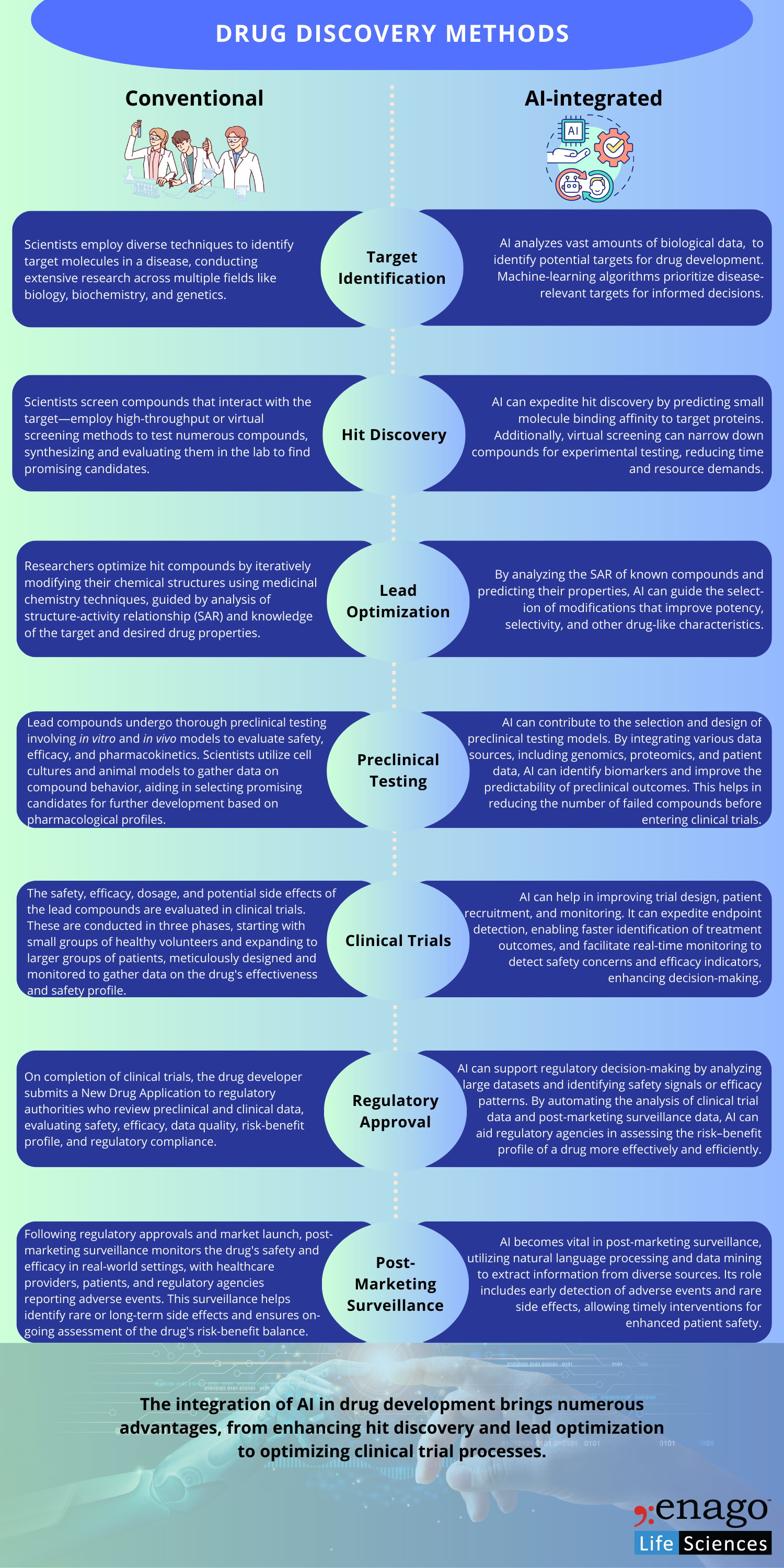Drug discovery is a dynamic and intricate field that strives to identify and develop novel medications to combat various diseases. For years now, scientists and pharmacists have been employing several methods to uncover potential drug candidates, develop them into drugs, and optimize their efficacy, safety, and pharmacokinetic properties. These methods encompass a diverse array of scientific disciplines and technologies, all aimed at unraveling the complexities of disease mechanisms and discovering molecules that can modulate these processes.
Artificial intelligence (AI) has emerged as a transformative force across various industries, and the field of drug discovery and development is no exception. AI offers us the ability to analyze vast amounts of data, identify patterns, and generate insights, and thus holds tremendous potential to revolutionize the way drugs are discovered and developed. By augmenting and accelerating traditional methods, AI offers opportunities to enhance efficiency, precision, and success rates in the drug-discovery pipeline.
Conventional Methods Vs AI-integrated Methods of Drug Discovery
The process for drug discovery and development involves a series of complex steps, from target identification to regulatory approval. It is characterized by numerous challenges, including identifying appropriate targets, optimizing lead compounds, conducting rigorous preclinical and clinical testing, navigating regulatory requirements, and monitoring post-marketing safety. While scientists have been developing and advancing the pharmaceutical industry, an AI-integrated system could streamline the process further and may enable scientists to research and discover revolutionary medicines.

The use of AI in drug development offers benefits such as improving hit discovery, lead optimization, and preclinical testing. AI algorithms can predict binding properties, enhance analysis in virtual screening, and guide lead compound selection. AI-based approaches can also aid in predicting bioactivity and toxicity, optimizing clinical trial design, patient identification, recruitment, and monitoring. Additionally, AI enables real-time monitoring, patient adherence, and endpoint detection, improving the efficiency and quality of clinical trials. These advancements have the potential to transform the drug-development process, making it more cost-effective, safer, and faster.1
Role of AI in Identifying Therapeutic Targets and Understanding Disease Mechanisms
By harnessing the power of advanced computational algorithms, machine learning, and data analysis techniques, AI has become an indispensable tool for researchers in understanding the underlying causes of diseases and accelerating the discovery of novel treatments.2 AI plays a crucial role in identifying therapeutic targets and understanding disease mechanisms by analyzing large-scale data and making complex connections.
Data Integration: AI algorithms can integrate and analyze diverse data sources, including genomics, proteomics, transcriptomics, and clinical data, to identify patterns and correlations. This enables the identification of potential therapeutic targets and provides insights into disease mechanisms.
Target Prioritization: It can help prioritize potential therapeutic targets based on various criteria, such as their relevance to the disease, drugability, and likelihood of success. By analyzing data on target expression, function, and interactions, AI algorithms can identify high-value targets for further investigation.
Knowledge Discovery: AI techniques, such as machine learning and natural language processing, can analyze vast amounts of scientific literature and databases to extract valuable knowledge about disease mechanisms and potential target–disease associations. This helps researchers uncover hidden relationships and generate hypotheses for further exploration.
Network Analysis: It can construct and analyze complex biological networks, such as protein–protein interaction networks and signaling pathways, to understand the interconnectedness of molecules and pathways involved in disease. This enables the identification of key nodes and interactions that can be targeted for therapeutic interventions.
Drug Repurposing: AI algorithms can screen existing drugs and compounds against a wide range of disease-related targets, identifying potential opportunities for drug repurposing. By predicting drug–target interactions and evaluating the safety and efficacy of repurposed drugs, AI accelerates the identification of new treatment options.
Biomarker Discovery: AI techniques can identify potential biomarkers associated with disease progression, treatment response, or patient stratification. By analyzing multidimensional data, including genomic, proteomic, and imaging data, AI can uncover molecular signatures that can serve as diagnostic or prognostic markers and guide personalized therapies.
AI enables researchers to leverage the power of data and computational analysis to identify therapeutic targets, understand disease mechanisms, and accelerate the drug-discovery process.
Examples of Successful Target Identification with AI
Example 1:
In a groundbreaking study led by Daniil Polykovskiy and his team, the potential of artificial intelligence (AI) in predicting the activity of synthesized molecules was explored. This study titled “Entangled Conditional Adversarial Autoencoder for de Novo Drug Discovery” was published in Molecular Pharmaceutics. The research revealed promising results, indicating that AI has the capability to enhance the accuracy and reliability of the drug screening process. The authors presented an Entangled Conditional Adversarial Autoencoder (ECAAE) that incorporates various disentanglement techniques to enhance the quality of generated molecules. Their model was applied to generate molecules with specific property descriptors, including solubility and synthetic accessibility scores. Additionally, they conditioned the model on target-specific properties such as binding energy or IC50. Notably, the ECAAE successfully identified a promising hit compound with high selectivity against the JAK3 isoform compared to JAK2 and RAF kinases.3The proposed architecture has the potential to generate novel molecules with favorable scaffolds. These findings highlight the ability of ECAAE to be integrated into automated drug discovery pipelines, facilitating the generation of extensive sets of initial hypotheses for drugs targeting various disease areas.3 Furthermore, the study uncovered valuable insights into the target molecule, highlighting the feasibility of integrating AI into automated drug-discovery pipelines. This integration could potentially generate an extensive array of initial drug hypotheses for a diverse range of diseases, presenting exciting possibilities for advancing drug-development and treatment strategies.
Example 2:
The paper titled “eToxPred: a machine-learning-based approach to estimate the toxicity of drug candidates,” published in BMC Pharmacology and Toxicology, reports the development of a sophisticated AI software called eToxPred, designed to forecast the toxicity levels of diverse synthetic and biological compounds. The primary aim of this AI model was to minimize the necessity for extensive clinical trials. Impressively, the eToxPred system demonstrated remarkable accuracy in predicting toxic properties, achieving a success rate of over 72% across various cases. Furthermore, the overall error rate of the predictions was a mere 4%, indicating a high level of precision. Such precise toxicity predictions hold significant potential in reducing reliance on extensive clinical trials, making the eToxPred software a valuable tool in drug development and safety assessment. 4
Ethical Considerations and Regulatory Challenges of AI in Drug Discovery
Ensuring the ethical and fair use of AI for the development of new therapeutic compounds is an important consideration that must be addressed.5
- Transparency and explainability: Ensuring transparency and interpretability of AI algorithms used in drug discovery is important to understand the decision-making process and facilitate regulatory scrutiny.
- Bias mitigation: Efforts must be made to address and mitigate bias in AI models to prevent biased predictions and decision-making in drug discovery. This includes addressing biases in training data that can lead to disparities in healthcare outcomes.
- Data privacy and security: The use of large datasets in AI-driven drug discovery raises concerns about data protection and patient privacy. Regulatory frameworks need to establish guidelines and safeguards for the collection, storage, and sharing of sensitive health data.
- Regulatory adaptation: Traditional regulatory pathways may not be suited to evaluate the unique features of AI algorithms and their continuous learning capabilities. Developing appropriate regulatory frameworks is necessary to assess the safety, efficacy, and quality of AI-driven drug discovery processes.
- Validation and verification: Robust validation and verification processes are needed to ensure the reliability and reproducibility of AI-generated findings. Establishing validation standards and guidelines specific to AI-driven drug discovery can ensure the quality and credibility of the results.
- Societal implications: The broader societal impact of AI in drug discovery, including potential job displacement and changes in healthcare roles, should be considered. Ethical considerations should focus on responsible use and minimizing adverse effects on employment and healthcare delivery.
- Collaboration and stakeholder involvement: Addressing ethical considerations and regulatory challenges requires collaboration among researchers, regulators, policymakers, and stakeholders. Developing guidelines, standards, and frameworks specific to AI-driven drug discovery can promote responsible and ethical use of AI while ensuring patient safety and equitable healthcare outcomes.6
Overall, the integration of AI in drug discovery and development holds great promise in accelerating the process, reducing costs, and improving the success rate of bringing safe and effective drugs to the market. However, it is important to note that AI is a tool that complements human expertise and decision-making, and regulatory oversight and ethical considerations remain essential in the development and deployment of AI-driven solutions in this domain.7
References:
- Bhattamisra, Subrat Kumar, Priyanka Banerjee, Pratibha Gupta, Jayashree Mayuren, Susmita Patra, and Mayuren Candasamy. 2023. “Artificial Intelligence in Pharmaceutical and Healthcare Research.” Big Data and Cognitive Computing7 (1): 10. https://doi.org/10.3390/bdcc7010010.
- Ranson, Janice M., Magda Bucholc, Donald Lyall, Danielle Newby, Laura Winchester, Neil P. Oxtoby, Michele Veldsman, et al. 2023. “Harnessing the Potential of Machine Learning and Artificial Intelligence for Dementia Research.” Brain Informatics10 (1). https://doi.org/10.1186/s40708-022-00183-3.
- Polykovskiy, Daniil, Alexander Zhebrak, Dmitry Vetrov, Yan Ivanenkov, Vladimir Aladinskiy, Polina Mamoshina, Marine Bozdaganyan, Alexander Aliper, Alex Zhavoronkov, and Artur Kadurin. 2018. “Entangled Conditional Adversarial Autoencoder for de Novo Drug Discovery.” Molecular Pharmaceutics15 (10): 4398–4405. https://doi.org/10.1021/acs.molpharmaceut.8b00839.
- Pu, Limeng, Misagh Naderi, Tairan Liu, Hsiao-Chun Wu, Supratik Mukhopadhyay, and Michal Brylinski. 2019. “EToxPred: A Machine Learning-Based Approach to Estimate the Toxicity of Drug Candidates.” BMC Pharmacology and Toxicology20 (1). https://doi.org/10.1186/s40360-018-0282-6.
- Hajime Shimao, Warut Khern-am-nuai, Karthik N Kannan, and Maxime C Cohen. 2022. “Strategic Best Response Fairness in Fair Machine Learning,” July. https://doi.org/10.1145/3514094.3534194.
- Blanco-González, Alexandre, Alfonso Cabezón, Alejandro Seco-González, Daniel Conde-Torres, Paula Antelo-Riveiro, Ángel Piñeiro, and Rebeca Garcia-Fandino. n.d. “The Role of AI in Drug Discovery: Challenges, Opportunities, and Strategies.” https://arxiv.org/ftp/arxiv/papers/2212/2212.08104.pdf.
- Santoro, Helen. 2022. “Bringing Principles of Ethics to AI and Drug Design.” Scope. April 2022. https://scopeblog.stanford.edu/2022/04/01/bringing-principles-of-ethics-to-ai-and-drug-design%EF%BF%BC/.
Author:

Uttkarsha Bhosale
Editor, Enago Academy
Medical Writer, Enago Life Sciences
Connect with Uttkarsha on LinkedIn

